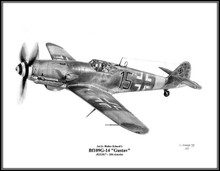 Loading... Please wait...
Loading... Please wait...- Home
- Combat Aircraft/Pencil Drawings ~ Free Shipping
- Messerschmitt Bf109G-14 "Gustav" (Lt. Walter Schuck) ~ Free Shipping
Product Description
Print Size 8½" x 11" ~ Unlimited print edition
The G-14, appearing in mid-1944 was basically a late-war Bf 109 G-6 with the aforementioned improvements standardized, and with MW 50 methanol/water injection increasing output to 1800 hp being a standard fitting. High-altitude models of the G-14 received the DB 605ASM engine and were named G-14/AS. There was increasing tendency to use wood on some less vital parts (e.g. on a taller tailfin/rudder unit, pilot seat or instrument panel) - not because of the shortage of strategic materials like aluminium as often suggested, but as it allowed freeing up metalworking capacity by involving of the woodworking industry of more parts. The G-10 was an attempt to match the proven Bf 109 G-6/G-14 airframe with the new and more powerful DB 605D engine with minimal distruption of the production lines. Despite what the designation would suggest, it appeared in service after the G-14 and somewhat the K-4 in November 1944. Early production G-10s used fuselages taken from the G-14 production lines, this was probably a source of confusion as many authors still believe many G-10 were based on recycled G-series fuselages. The most recognizable change was the standardized use of the "Erla-Haube" canopy, sometimes referred to (incorrectly) as the 'Galland' hood. This canopy improved the pilot's view by reducing the number of support struts, which was often criticized before. The G-10 was produced in very substantial numbers, with some 2600 G-10s produced until the war's end. The Bf 109 G-10, AS-engined G-5s, G-6s and G-14s as well as the K-4 saw a refinement of the bulges covering the breeches of the cowl mounted MG 131, these taking on a more elongated and streamlined form, barely discernible on the upper sides of the cowl panels, as the large engine supercharger required a redesign of the cowling. A similar varying product was the Bf 109 G-12. This was a two-seat trainer version of the Bf 109 and was rarely armed with anything more than the two cowling machine guns. The space needed for the second cockpit was gained by reducing the internal fuel capacity to only 240 l thus they nearly always used the 300 l drop tank as standard equipment. The G-12 was built using a wide variety of G-series fuselages, many were G-2 based but several were built of rebuilt/repaired G-1, G-4 and G-6.
Warranty Information
null








